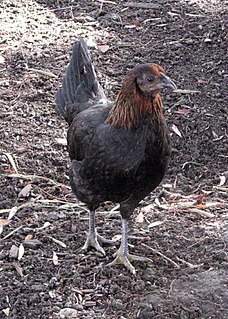
The American Game is an American breed of game fowl, chickens bred specifically for cockfighting. It has many color varieties, and may also be kept for ornament.

The Orpington or Buff Orpington Duck is a breed of domestic duck. It is a dual-purpose breed used for meat and egg production. It is capable of laying up to 220 eggs a year. Originally created by William Cook of Orpington, Kent, UK, from the selection of mis-marked Blue Orpington Ducks; Cook was also the developer of the Orpington chicken. The breeds used in the development of the breed included Cayuga, Indian Runner, commercial Aylesbury and Rouen. It is proposed that Cook's intentions for the breed were to capitalize on the growing demand for the buff colour pattern. The Buff Orpington Duck was introduced to the public at the Dairy Show, the Agricultural Hall (q.v.), Islington, London in October 1897. It is considered a threatened breed by the ALBC. This breed was admitted to the British Poultry Standard in 1910 and the American Poultry Associations Standard of Perfection as the 'Buff Duck' in the Medium class in 1914. The Orpington duck is available in three colour varieties: Buff, Blond and Brown. The Buff Orpington is an unstable colour due to a blue dilution gene which means that from the offspring, all three colour variations will appear.

The Bourbon Red is a breed of domestic turkey named for its unique reddish plumage and for Bourbon County, Kentucky. The breed standard indicates that mature Bourbon Red toms (males) weigh 15 kilograms, and mature hens (females) weigh 8.2 kilograms. The breed standard indicates the Bourbon Red should weigh 10.4 kilograms for toms and 6.3 kilograms for hens at slaughter age. These standard weights were published with anticipation of the potential of the Bourbon Red and when the breed was at its prime. Though there are efforts to restore and accomplish the Bourbon Red standard, today these weights are realized by few breeders and growers. Bourbon Reds have been unrefined for too long due to the lack of selective breeding to preserve the breed. However, mature turkeys in a breeding flock will exhibit an intense fluctuate ~30% from these published weights due to their relentless, extensive and highly instinctive breeding season with their lowest weights typically being recorded in July.

The Magpie is a British breed of domestic duck. It has distinctive black and white markings reminiscent of the European magpie, and is a good layer of large eggs.

The Buckeye is an American breed of chicken. It was created in Ohio in the early nineteenth century by Nettie Metcalf. The color of its plumage was intended to resemble the color of the seeds of Aesculus glabra, the Ohio Buckeye plant for which the state is called the 'Buckeye State'.
The Nankin Bantam or Nankin is a British bantam breed of chicken. It is a true bantam, a naturally small breed with no large counterpart from which it was miniaturised. It is of South-east Asian origin, and is among the oldest bantam breeds. It is a yellowish buff colour, and the name is thought to derive from the colour of nankeen cotton from China.
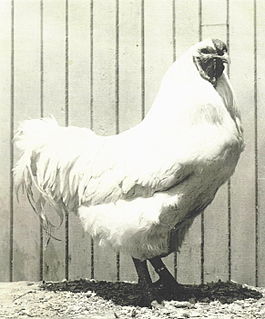
The Chantecler is a breed of chicken originating in Canada. The Chantecler was developed in the early 20th century, at the Abbey of Notre-Dame du Lac in Oka, Quebec. It is extremely cold-resistant, and is suitable for both egg and meat production.

The Rhode Island White is a breed of chicken originating in the U.S. state of Rhode Island. Despite their very similar names and shared place of origin, the Rhode Island White is a distinct breed from the Rhode Island Red. However, Rhode Island Reds and Whites can be bred together to create Red Sex-Link hybrid chickens, such as the ISA Brown. In Australia, the Rhode Island White is regarded as a color variety of the Rhode Island breed according to the Australian Poultry Standards.

The Delaware is a breed of chicken originating in the U.S. state of Delaware. It was once of relative importance to the U.S. chicken industry, but today is critically endangered. It is primarily suited to meat production but also lays reasonably well. It has plumage of a unique pattern, and is accepted into poultry standards for showing.

The Java is a breed of chicken originating in the United States. Despite the breed's name, a reference to the island of Java, it was developed in the U.S. from chickens of unknown Asian extraction. It is one of the oldest American chickens, forming the basis for many other breeds, but is critically endangered today. Javas are large birds with a sturdy appearance. They are hardy, and are well-suited for both meat and egg production, especially by small-scale farms, homesteads, and backyard keepers.
The Iowa Blue is a breed of chicken that originated near Decorah, Iowa, in the early twentieth century. Despite its name, the breed is not actually blue according to poultry standards. It is an exceedingly rare fowl, and is not recognized for showing by the American Poultry Association. They are a dual-purpose breed laying brown eggs and known to be good foragers.

The Vorwerk is a breed of chicken originating in Germany. Though it is unrelated to the German company which produces the Vorwerk vacuum cleaner, it is the only chicken to share its name with a brand of household appliance. A rare fowl, it has distinctive black-and-gold plumage.
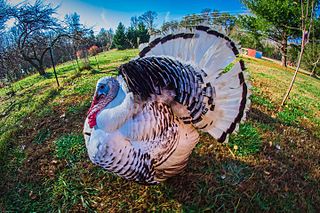
The Royal Palm is a breed of domestic turkey. It is not primarily selected for meat production, and is usually kept as an ornamental bird with a unique appearance, largely white with bands of metallic black.

A heritage turkey is one of a variety of strains of domestic turkey which retains historic characteristics that are no longer present in the majority of turkeys raised for consumption since the mid-20th century. Heritage turkeys can be differentiated from other domestic turkeys in that they are biologically capable of being raised in a manner that more closely matches the natural behavior and life cycle of wild turkeys. Heritage turkeys have a relatively long lifespan and a much slower growth rate than turkeys bred for industrial agriculture, and unlike industrially bred turkeys, can reproduce without artificial insemination.

The Norfolk Black, also known as the Black Spanish or Black Turkey, is a British breed of domestic turkey. It is thought to derive from birds taken to Britain from Spain, where they had arrived with Spanish explorers returning from the New World.
The Slate, or Blue Slate, is a breed of domestic turkey known for the slate gray color of its plumage. Lighter birds are sometimes called Lavender turkeys. Turkeys of the Slate breed may actually be any number of shades between pure black and white, but only ash-gray birds are eligible for showing under the directive of the American Poultry Association’s ‘’Standard of Perfection’’, into which they admitted as a variety in 1874. Slate turkeys are listed as critically endangered by the American Livestock Breeds Conservancy, and meet the definition of a heritage turkey breed.
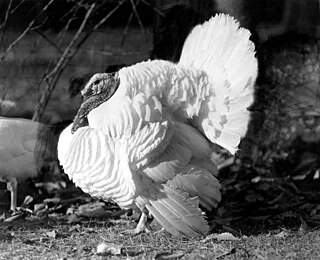
The Beltsville Small White is a breed of domestic turkey. The bird was named after its physical characteristics—a relatively small size and entirely white plumage—as well as its place of origin: the United States Department of Agriculture's Beltsville Agricultural Research Center in Maryland.
The Buff or Jersey Buff is a breed of domestic turkey named for its buff-colored plumage.
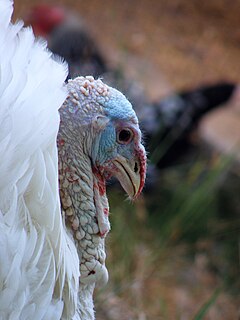
The Midget White is a breed of domestic turkey named for its white plumage and small stature. The breed is the smallest standard variety of turkey, and with toms at roughly 13 lbs and hens 8-10 lbs, it weighs only slightly more than the largest chickens.















